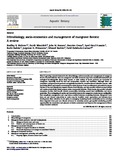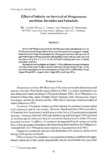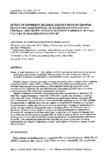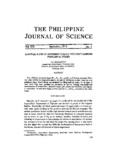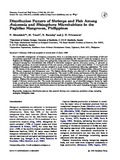Search
Now showing items 31-40 of 59
Gill structure, anatomy and habitat of Anodontia edentula: Evidence of endosymbiosis
(National Shellfisheries Association, 2001)
Surveys and interviews were conducted to determine sources and habitat of Anodontia edentula. Results showed that they inhabit muddy substrate of mangrove areas or the adjacent mudflats, burying at 20-60 cm deep in the ...
Ethnobiology, socio-economics and management of mangrove forests: A review
(Elsevier, 2008)
There is growing research interest in the ethnobiology, socio-economics and management of mangrove forests. Coastal residents who use mangroves and their resources may have considerable botanical and ecological knowledgeable ...
A review of mangrove rehabilitation in the Philippines: successes, failures and future prospects
(Springer, 2008)
From half a million hectares at the turn of the century, Philippine mangroves have declined to only 120,000 ha while fish/shrimp culture ponds have increased to 232,000 ha. Mangrove replanting programs have thus been ...
Mangroves and brackishwater pond culture in the Philippines
(Springer Verlag, 1995)
Around 50% of mangrove loss in the Philippines can be traced to brackishwater pond construction. The decrease in mangroves from 450 000 ha in 1920 to 132 500 ha in 1990 has been accompanied by expansion of culture ponds ...
Effect of salinity on survival of Metapenaeus anchistus juveniles and subadults
(University of the Philippines in the Visayas, 1997)
Survival of Metapenaeus anchistus (De Man) juveniles and subadults at 5, 15, 25, 35 (control) and 45 ppt salinity levels was determined and compared. Salinity levels lower than 35 ppt level were prepared by diluting pure ...
The way forward with ecosystem-based management in tropical contexts: Reconciling with existing management systems
(Elsevier, 2012)
This paper discusses some of the challenges and opportunities that can arise when implementing ecosystem-basedmanagement (EBM) in tropical nations. EBM creates a new series of challenges, problems, and opportunities that ...
Preliminary results of feeding aquatic macrophytes to Penaeus monodon juveniles
(Elsevier, 1989)
Penaeus monodon juveniles (PL<sub>50</sub>) were fed live and decaying aquatic macrophytes and a commercial grow-out pellet (40% crude protein) in 80-l glass tanks over a 30-day period. Growth and survival were significantly ...
Effect of different stocking combinations on growth, production and survival of milkfish (Chanos chanos Forskal) and prawn (Penaeus monodon Fabricius) in polyculture in brackishwater ponds
(Elsevier, 1981)
Milkfish (Chanos chanos) and prawn (Penaeus monodon) were stocked in 500 m2 earthen ponds from 12 November 1978 to 15 March 1979 at the following combinations: 2000 milkfish fingerlings per ha (treatment I); 2000 milkfish ...
Survival rates of different Penaeus monodon Fabricius postlarval stages
(National Science Development Board, 1976)
Four different postlarval stages (P<sub>11</sub>, P<sub>15</sub> , P<sub>21</sub>, and P<sub>25</sub>) of P. monodon were stocked in suspension nets at the rate of 200 fry/sq m with 3 nets for each postlarval stage. Pond ...
Distribution pattern of shrimps and fish among Avicennia and Rhizophora microhabitats in the Pagbilao mangroves, Philippines
(Elsevier, 1999)
For sustainable management of mangrove ecosystems, there is a pressing need to increase our knowledge of fish and invertebrates associated with this system. This study sampled microhabitats (89–258 m<sup>2</sup>) ...



